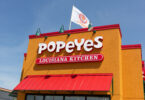Olive Garden is an Italian-themed restaurant chain that has become a household name in the United States. Founded in 1982, the restaurant chain has grown to over 800 locations across the country, making it one of the largest Italian restaurant chains in the world. Olive Garden is known for its casual dining experience, warm breadsticks, and unlimited salad and soup.

The history of Olive Garden is a fascinating story of growth and evolution. The restaurant chain was founded by General Mills in 1982, with the first location opening in Orlando, Florida. Olive Garden’s commitment to authentic Tuscan cooking led to the creation of a culinary institute in Tuscany in 1999. The brand sends hundreds of its managers and chefs to spend time at the institute to further their understanding of Italian cuisine, a unique selling proposition that sets Olive Garden apart from other Italian restaurant chains.
Key Takeaways
- Olive Garden is an Italian-themed restaurant chain with over 800 locations across the United States.
- The restaurant chain was founded by General Mills in 1982 and is known for its commitment to authentic Tuscan cooking.
- Olive Garden’s unique selling proposition is its culinary institute in Tuscany, where managers and chefs are sent to further their understanding of Italian cuisine.
Founding and Early Years

Olive Garden, an American casual dining restaurant chain specializing in Italian-American cuisine, was founded on December 13, 1982, in Orlando, Florida, as a unit of General Mills. The first Olive Garden restaurant was opened in Orlando, and by 1989, there were 145 Olive Garden restaurants, making it the fastest-growing units in the General Mills restaurant division.
In 1982, Bill Darden, the founder of Red Lobster, founded Olive Garden with the aim of creating a restaurant that would serve authentic Italian food in a relaxed and casual atmosphere. Darden believed that people would appreciate the simplicity and freshness of Italian cuisine, and he was right. Olive Garden quickly became a popular destination for people looking for a casual dining experience.
The name “Olive Garden” was chosen because olive trees are a symbol of peace, and the garden represents a place of tranquility and relaxation. The restaurant’s logo, a simple handwritten-style script reading “the Olive Garden” in kelly green, gestured toward elegance.
Olive Garden’s commitment to authentic Tuscan cooking led to the creation in 1999 of a culinary institute in Tuscany. The brand sends hundreds of its managers and chefs to spend time at the institute to further their understanding of Italian cuisine.
In 1995, Olive Garden became a subsidiary of Darden Restaurants, Inc., which is headquartered in Orange County, Florida. As of 2022, Olive Garden restaurants accounted for $4.5 billion of the $9.63 billion revenue of its parent, Darden.
Acquisition by Darden Restaurants

In 1982, Olive Garden was founded by Bill Darden in Orlando, Florida. The restaurant chain quickly gained popularity and by 1989, General Mills had opened over 145 restaurants, making it the fastest-growing unit in the company’s restaurant holdings.
In 1995, Darden Restaurants acquired Olive Garden, making it a part of their portfolio of restaurant chains. This acquisition marked the beginning of Darden’s strategy to diversify its offerings and cater to a wider range of customers.
After the acquisition, Darden Restaurants continued to expand its portfolio by acquiring other restaurant chains. However, Olive Garden remained one of their most successful brands.
In 2011, Darden announced that it was going to begin co-locating Olive Garden and sibling chain Red Lobster locations. The new restaurants were designed for smaller markets and had separate entrances and dining areas, but unified kitchen and support areas.
Today, Olive Garden is a well-known Italian-themed restaurant chain with over 850 locations worldwide. Darden Restaurants continues to own and operate Olive Garden as one of its flagship brands.
Menu Evolution

Olive Garden has a history of changing its menu over time to meet the evolving tastes of its customers. The restaurant chain has introduced new dishes and retired old ones, experimented with new ingredients and cooking techniques, and revamped its menu design and presentation.
Wanna check out the Olive Garden menu? Visit our rundown here.
Go to our Olive Garden specials page here to learn about current promotions. Our personal favorite is their popular Never Ending Pasta program! There’s nothing like throwing down a day’s worth of carbs in one sitting!
Signature Dishes
One of Olive Garden’s most popular signature dishes is its unlimited breadsticks. These warm, garlicky breadsticks are a staple of the restaurant’s menu and are served with every meal. Another signature dish is the house salad, which features a mix of lettuce, tomatoes, onions, black olives, and croutons, topped with a signature Italian dressing.
Olive Garden’s pasta dishes are also a popular choice among customers, with classics such as spaghetti and meatballs, fettuccine alfredo, and chicken parmesan. The restaurant also offers seasonal specials that incorporate fresh, seasonal ingredients into their dishes.
Seasonal Specials
Olive Garden’s seasonal specials are a way for the restaurant to keep its menu fresh and exciting while also offering customers new and unique dishes to try. Some of the most popular seasonal specials include the never-ending pasta bowl, which allows customers to choose from a variety of pasta dishes and sauces, and the unlimited soup, salad, and breadsticks, which offers unlimited refills of these classic dishes.
In recent years, Olive Garden has also introduced new menu items that incorporate more diverse flavors and ingredients. Some of these new dishes include grilled chicken piadina, shrimp scampi, and chicken alfredo pizza. These new menu items have helped to keep Olive Garden relevant and appealing to a wider range of customers.
Overall, Olive Garden’s menu evolution has been a key factor in the restaurant’s success. By listening to customer feedback and adapting to changing tastes and trends, Olive Garden has been able to stay relevant and maintain its position as a top Italian restaurant chain in the United States.
Unique Selling Propositions

Olive Garden has several unique selling propositions that make it stand out from other Italian-themed chain restaurants. One of the most popular and well-known propositions is the unlimited salad and breadsticks that come with every meal. This has been a hallmark of the restaurant since its inception and is a big draw for families and those looking for casual dining options.
Another unique selling proposition is the pasta pass. This is a limited-time offer that allows customers to purchase a pass that gives them unlimited pasta for a set period of time. Olive Garden has offered different versions of this pass, including the lifetime pasta pass and the never-ending pasta pass, which have both been very popular with customers.
Olive Garden also offers a three-course meal that includes an entrée, soup or salad, and a dessert. This is a great value for customers looking for a full dining experience at an affordable price.
In addition, Olive Garden has a secret menu that is only available to those in the know. This menu includes items that are not listed on the regular menu and can only be ordered by asking for them specifically.
Overall, Olive Garden’s unique selling propositions make it a popular choice for those looking for casual Italian-American cuisine in a family-friendly atmosphere. With unlimited salad and breadsticks, the pasta pass, the three-course meal, and the secret menu, there is something for everyone at Olive Garden.
Culinary Institute of Tuscany

Olive Garden, the popular Italian-American restaurant chain, has a Culinary Institute of Tuscany located in Riserva di Fizzano, a charming 11th-century hamlet in Tuscany, Italy. The institute offers chefs and managers from Olive Garden restaurants across the United States the opportunity to learn about authentic Italian cuisine and gastronomic practices.
The Culinary Institute of Tuscany was established in 1999 and has been providing 11-week courses each winter to approximately 100 of the best-performing chefs and managers from Olive Garden restaurants. The aim of the courses is to teach the participants about the history and culture of Italian food, as well as the techniques and ingredients used in traditional Italian cooking.
The institute is located in a beautiful setting in Tuscany, which provides the perfect backdrop for the participants to immerse themselves in Italian culture and food. The courses at the institute include hands-on cooking classes, wine tastings, and visits to local markets and producers.
The Culinary Institute of Tuscany has received mixed reviews from former participants. Some have praised the institute for providing an authentic Italian experience and teaching them valuable skills and techniques. Others, however, have criticized the institute for being more of a vacation than an educational experience.
Overall, the Culinary Institute of Tuscany is an interesting initiative by Olive Garden to promote authentic Italian cuisine and provide its chefs and managers with an opportunity to learn about Italian gastronomy.
Marketing and Advertising

Olive Garden has been able to build a strong brand identity through effective marketing and advertising campaigns. The chain has been successful in distinguishing itself from its competitors and fostering customer loyalty. Olive Garden’s marketing efforts have been crucial in making it a household name in the American casual dining industry.
The company spends a significant portion of its revenue on advertising and marketing. In the last year, Olive Garden spent under $100 million on advertising in digital, print, and national TV. They invest in premium ad units and advertised on over 250 different media properties in the last year across multiple media formats.
One of the most notable advertising campaigns of Olive Garden was in Times Square, New York City. In 2012, Olive Garden launched a new advertising campaign in Times Square, which included a giant breadstick and a 700-pound bowl of pasta. The campaign aimed to attract more customers and to promote the chain’s unlimited breadsticks and pasta.
Olive Garden has also been associated with the former President of the United States, Donald Trump. In 2016, Olive Garden’s parent company, Darden Restaurants, donated $1 million to Trump’s presidential campaign. The decision was met with criticism, and Olive Garden faced a boycott campaign on social media. Despite the controversy, Olive Garden’s sales did not seem to be affected.
Overall, Olive Garden’s marketing and advertising efforts have been crucial in making it a successful chain in the American casual dining industry. The company’s investment in advertising and marketing has helped it to establish a strong brand identity and to foster customer loyalty.
Expansion and Growth

Olive Garden’s exceptional food and inviting ambiance struck a chord with diners, leading to rapid expansion. By 1993, Olive Garden had surpassed 400 restaurants across the United States, making it one of the fastest-growing chains in the restaurant industry.
Domestic Growth
Olive Garden continued to grow domestically, expanding its reach to Canada, Peru, and Brazil. By 2019, Olive Garden had over 850 locations in the United States and Canada alone. The chain’s growth was fueled by its ability to adapt to changing consumer preferences, such as offering more vegetarian and gluten-free options.
To keep up with demand, Olive Garden also increased its hiring efforts, creating part-time and full-time job opportunities for thousands of people across the country. The chain’s commitment to creating a positive work environment has earned it numerous awards and accolades, including being named one of the “100 Best Companies to Work For” by Fortune magazine.
International Expansion
In addition to its domestic growth, Olive Garden has also expanded its reach to international markets through franchising partnerships. In 2011, the chain opened its first location in Kuwait, followed by locations in Guayaquil, Ecuador, and Mexico City. Olive Garden has also opened locations in Gran Plaza and Cancun in Mexico, as well as in the Philippines and Aruba.
The chain’s expansion into international markets has been met with success, as Olive Garden’s signature dishes have been well-received by diners in these regions. The chain’s ability to adapt its menu to local tastes and preferences has played a key role in its success in international markets.
Overall, Olive Garden’s expansion and growth over the years have solidified its position as an iconic Italian restaurant chain, beloved by diners across the United States and around the world.
Controversies and Challenges

Olive Garden has faced several controversies and challenges over the years. One of the most notable controversies happened in 2014 when activist hedge fund Starboard Value called out Olive Garden for its mandatory tip-out program. Starboard Value claimed that the program was unfair to servers and that it resulted in lower earnings for them. Olive Garden responded by stating that the program was necessary to ensure that all employees received fair compensation.
Another controversy that Olive Garden faced was in 2016 when it was accused of making false claims about its food. A class-action lawsuit was filed against the restaurant chain, alleging that it misled customers by claiming that its chicken parmesan was made with fresh ingredients when it was actually made with frozen chicken. Olive Garden denied the allegations and settled the lawsuit for $6 million.
In addition to these controversies, Olive Garden has also faced challenges in terms of its menu offerings. In recent years, the restaurant chain has struggled to keep up with changing consumer tastes and preferences. As a result, it has had to revamp its menu several times to stay relevant. For example, in 2014, Olive Garden introduced a new menu that featured smaller portions and more customizable options in response to customers’ desire for healthier and more diverse food choices.
Despite these challenges, Olive Garden continues to be a popular destination for Italian-American cuisine. The restaurant chain has over 850 locations across the United States and is known for its unlimited breadsticks and soup/salad options.
Current Status and Future Prospects

Olive Garden, a subsidiary of Darden Restaurants Inc., is a full-service restaurant chain that specializes in Italian-American cuisine. The restaurant chain has been around since 1982 and has undergone several changes over the years. As of 2023, Olive Garden has over 850 locations in the United States and is known for its signature dishes such as unlimited breadsticks and salad.
Under the leadership of CEO Gene Lee and COO Rick Cardenas, Olive Garden has been making efforts to stay relevant in the ever-changing restaurant industry. One of the ways the company has done this is by introducing lunch portions of their popular dishes. This move has been successful in attracting customers who are looking for a quick and affordable lunch option.
In addition to introducing lunch portions, Olive Garden has also invested in online ordering capabilities. This move has been successful, with the brand receiving over 30,000 online orders per week. The company’s takeout business currently accounts for 8.6% of its total sales and is expected to grow in the future.
Olive Garden has also undergone rebranding efforts in recent years. The company has updated its logo to a more modern design, while still retaining its classic look. This move was aimed at attracting younger customers while still retaining its loyal customer base.
Darden Restaurants Inc. has also been co-locating Olive Garden and Red Lobster locations in smaller markets. The new restaurants have separate entrances and dining areas but share kitchen and support areas. This move has been successful in reducing costs and increasing efficiency.
Despite the challenges faced by the restaurant industry, Olive Garden has continued to perform well. The company has reported 17 consecutive periods of positive gains in same-store sales, with a growth rate of 3.5% in the second quarter of fiscal 2019. With its focus on innovation and customer satisfaction, Olive Garden is well-positioned to continue its success in the future.
Frequently Asked Questions

When did Olive Garden first open?
Olive Garden first opened its doors on December 13, 1982, in Orlando, Florida. It was founded by General Mills as part of their restaurant division.
What is the history of Olive Garden?
Olive Garden was founded in 1982 by General Mills. The restaurant chain was sold to Darden Restaurants in 1995. Since then, Olive Garden has expanded to over 800 locations worldwide. Olive Garden is known for its Italian-American cuisine and family-style dining.
Who is Bill Darden and what is his connection to Olive Garden?
Bill Darden is the founder of Darden Restaurants, the parent company of Olive Garden. He started his career in the restaurant industry in the 1940s and went on to found several successful restaurant chains, including Red Lobster and Olive Garden.
Is Olive Garden a franchise?
No, Olive Garden is not a franchise. It is owned and operated by Darden Restaurants, which also owns other restaurant chains such as LongHorn Steakhouse, Bahama Breeze, and Capital Grille.
Where is the original Olive Garden location?
The original Olive Garden location is in Orlando, Florida. It opened on December 13, 1982.
What is the oldest Italian restaurant in the country?
The oldest Italian restaurant in the country is reportedly Ristorante Fior d’Italia in San Francisco, California. It was founded in 1886 and is still in operation today.






